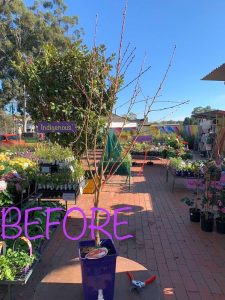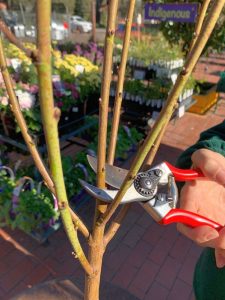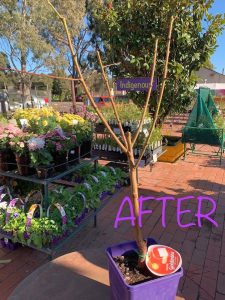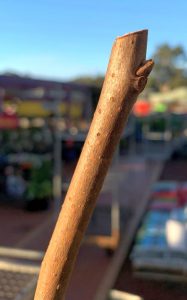Therese Scales on pruning of deciduous fruit trees
Therese Scales is a horticulturalist at Nillumbik Nursery in Diamond Creek.
Also, read Robin Gale-Baker’s article on the pruning and care of deciduous fruit trees.
The first part of this article focuses on pruning in the first few 4 years (formative pruning), whilst the second part focuses on the pruning of mature trees.
Formative pruning
 Why prune fruit trees? Shouldn’t we just let them grow to their natural form?
Why prune fruit trees? Shouldn’t we just let them grow to their natural form?
As simple as that sounds, it is not the way you get the best results from a fruit tree.
These rules generally apply to stone fruit, apples and pears:
- A strong framework of balanced branches needs to be developed to hold a good crop of fruit in years to come.
- Fewer branches hold larger fruit.
- A smaller tree makes it easy to pick fruit and to net the tree, as well as produce less excess fruit at risk of Queensland Fruit Fly.
- Opening the inside of the tree into a vase shape reduces the risk of pests and diseases developing.
- It allows sunshine in so fruit can ripen.
- Make sure your secateurs are clean and sharp. A clean cut will heal better than a tear. Remember to also
 clean your snips when you move between trees to prevent the spread of disease.
clean your snips when you move between trees to prevent the spread of disease. - Choose four higher outward growing branches (not crossing) to form the framework by which the fruit will produce fruiting spurs.
- Choose branches which are not directly opposite one another at the same point around the trunk to avoid splitting.
- Prune just above an outward facing bud to encourage outward growth. The cut needs to be angled away from the bud to protect it and allow water to run off. Be careful not to cut too close to the bud (to avoid damage) yet not too far from it (which may result in die back of the stem).
- The first prune should have about 60 percent of the growth removed. In subsequent years, you will not need to prune as severely. The formative pruning takes about four years. As well as removing branches which are crossing, diseased, dying or dead, the idea is to develop about eight branches around the trunk. So you want a lateral branch growing from each of the 4 branches you started with. In this time, remove any fruit before it gets too heavy for the small
 branches.
branches.
Do I really have to drop all fruit for 4 years?
In an ideal world … yes. It will encourage strong healthy branches and payoff in the long run.
If you just can’t wait… If you absolutely need to see some fruit from your labour… If you smile and nod when you’re told it all needs to go (only to get home and secretly enjoy your first fruit)… Significant fruit thinning is the bare minimum to allow for ongoing success.
Can you prune to contain the size?
Yes, but it isn’t a matter of doing it once and then you’re done. Rather, it will need to be done at least annually.
Pruning of mature trees
When the framework branches have been established (about 4 years), you can start pruning for the production of healthy fruit.
The first thing is to remove anything that is:
- Dead.
- Damaged.
- Diseased.
 Branches crossing through the centre of the tree.
Branches crossing through the centre of the tree.- Branches rubbing against one another.
- Branches growing vertically.
General pruning tips
- Keep tools clean and sharp.
- Prune to an outward facing bud to avoid congested growth in the centre of the tree and to open up that canopy for good light penetration and airflow.
- Use loppers or a pruning saw on large branches.
- Put the sharp edge of the blade next to the bud (spur or sprig) – close, but not too close.
- Angle the cut away from the bud.
- Avoid pruning in wet conditions because it increases the risk of infection at the new wound.
What is the difference between a spur and a sprig?
Fruit trees have either sprigs or spurs. Both carry the fruiting buds and form off lateral branches. Each lateral branch may have several spurs or sprigs.
A spur is thicker and longer. The fruiting buds that form along it will typically be larger and further apart.
Sprigs are thinner than spurs and clustered together. The fruiting buds along it tend to be smaller and closer together. Because sprigs are finer than spurs, keeping them shorter and close to the main limbs will help prevent them drooping and breaking.
Apples and pears
Carry fruit on spurs.
- Prune them to the 2nd bud and in the following year to the 1st bud.
- For the best fruit size, each fruiting spur should be about 120mm apart.
- Spurs can be removed after 6 seasons.
- Damaged or worn out spurs, once removed, will be replaced by new shoots close by.
Apricots
Carry fruit on sprigs.
- Sprigs bear fruit for 2-3 years.
- Remove old and weak sprigs to encourage new ones.
- Unlike most of your fruit trees, do not prune in Winter. Rather, prune apricots after harvest (late summer) to avoid gummosis.
Cherries
Carry fruit on spurs.
- Fruits on previous season’s spurs.
- Remove damaged, dead and diseased material.
- Cut framework branches back by one third to produce fruiting buds for next year.
- Unlike most of your fruit trees, do not prune in Winter. Rather, prune cherries after fruiting to avoid cutting away fruiting spurs for next season.
Peaches and nectarines
Carry fruit on sprigs.
- Produce fruit on previous season’s growth (and thus each sprig only fruits once).
- Remove all sprigs which have given fruit.
- If overcrowded, thin the sprigs by removing some – this will improve, not reduce, your yield.
Plums
Carry fruit on spurs.
- Prune anything out of reach and crossing branches.
- Not overly fussy.

